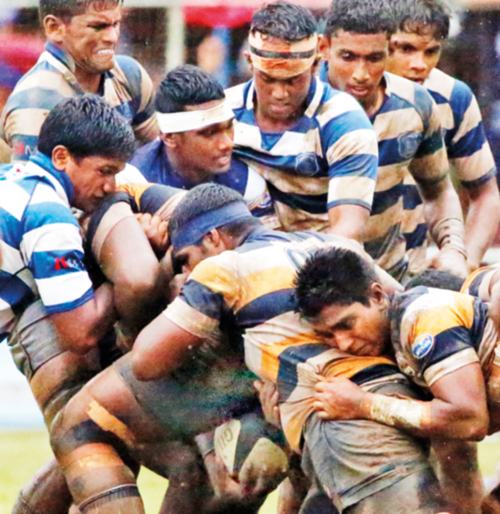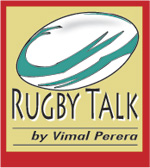It was not about Joes in the fight but the fight in the Joes
View(s):
The Joes stalled Petes from a win with 14 men
For St. Peter’s College it was an embarrassing loss, as nothing is going to sit on their mantelpiece. It is awkward for them to revisit, as St. Joseph’s defended a major part of the game with 14. It was not the defence that won them the match, but the fight they had with them. Defence was the fabric that helped them win the fight. To add insult to injury, the amateurish decision of not opting to take a penalty kick at goal, when you have the highest point scorer on your side. They lost the Rev. Fr Basil Wiratunga Memorial Shield, as well the hopes of laying hands on the Schools League title. Except that, this has made the League which was between two sides, becoming 3-cornered, provided Royal loses to St. Peter’s. This has also given a new hope to the other Saint. The result would be history by the time this column is in print.
It was the fight in the Joes, in a way never been seen on the Rugby fields of Sri Lanka, that made defence a weapon for victory. At Longdon Place last Saturday, we saw possibly the only time in Sri Lanka, winning a match by defending for most part of the game with 14 players. The Joes did well to hold on, unleashing tackle after tackle, to protect the score they recorded early in the game. In the International arena, a moment of Welsh Rugby history was the spellbinding defensive resolve of Warren Gatland’s side in 2015. In the 2015 game, the Welsh repelled wave after wave of Irish surges, in their 22 repelling 45 phases, executing non-stop, tackle after tackle, for 7 minutes. Perhaps the best display of defensive resolve in the history of Rugby.
The amateurish indecision of St. Peter’s and the pillars and posts common to both sides added suspense for 70 minutes of school Rugby. The underfoot conditions resulting from a heavy downpour, prevented more open Rugby and more entertainment. Given the bad ground conditions and the wet ball, both teams excelled in keeping the game alive. It had its moments that made Rugby worth watching. Compare this to the Club 7s which was a damp squib, and an exercise far below expectations, despite the glib pronouncements that Rugby in Sri Lanka has improved. Improved to such an extent that, we had Galle and Peterson’s joining the 7 of 8 Division ‘A’ Clubs, while the ‘B’ sides of the Services and Police helped to make 16 teams.
St. Peter’s have to blame themselves for not taking at least 3 kickable penalties, while they had the boots of the highest points scorer. Trailing 5-10, a penalty would have made it 10-8 and put pressure on the Joes. The quick tap and attempt to wean through, not once, but 3 times, was something one could not understand. With Joes mounting a solid defence, the chances of the maverick scrumhalf finding a gap, as he was used to, was a distant hope. The shortest route would have been 3 points over the bar and between the posts. It was like Oliver Twist wanting more and getting none?
While the Joes adapted to the conditions, by playing close and a solid defence, the other Saint dropped the metal by throwing long passes or cutting in when then line was starring at you. When running was difficult on a muddy ground, trying to cut in and jinx or, throwing a wet ball long, deprived points that mattered.
This match also saw the rare hyping of the Referee during broadcasts and in professional reviews in the electronic media. Then again, nobody is satisfied with a Referee, particularly, when you watch with blinkers. The dichotomy of the situation is that supporters of both sides are making a point to blame the Referee.
A major grumble is about the red for the lifting and dumping of the ball carrier. The 2018 Law book which is a simple wording reads: “A player must not lift an opponent off the ground and drop or, drive that player, so that, the head and/or upper body maks contact with the ground”. Explained around 2011, “lifting a ball carrier (opponent) from the ground and dropping that player (tipping) or, driving that player (spear) onto the ground, so they land on their upper body, neck or head.” World Rugby rang the bell around 2011 on the danger of this tackle, and now it is in Law. The emphasis is on player welfare and, as explained recently by a Sri Lanka World Rugby Medical Educator, concussion is not necessarily being banged or, being forced to the ground head first. It can also happen when a dangerous tackle makes your head snap back. The basic animal instinct in a human being is to land hands first. Inability to do that means, a player is defenseless and can have a serious head injury. This applies to taking the man in the air too. A citing officer will look for instances of this nature to substantiate a report of dangerous play. In this case the Tackler is stationary, the ball carrier was grasped below the hips and the player was lifted straight up, the player was turned beyond the horizontal and dropped and/or driven to the ground. Were all the ingredients there for the cake? To me it looked two turns.
The issue of pillars and posts was for both sides. Then a question asked is about hands in the ruck, where it is matter of timing the decision and applying the Law.
 On the other hand, look at the positives of Young Aaqil Jamaldeen, he showed promise, as he correctly penalized the tackler and the tackled for non-release, and ensured quicker ball in the conditions. He did not hesitate on the ‘Red’ and showed building of character. Given the ground conditions, he managed the scrum and post line-out formation. At a young age, he showed remarkable calm in a tense match, where the crowds were in numbers and vociferous. What needs to be sucked in is that, you are the Referee and all else, including the AR and TMO, are only a support. Yet, the decision to call for a review on the lift tackle was good, as on plain looking, it may have been a yellow. Pillars and posts which is plaguing almost all Referees, and there was no exception in this game too, was common to both sides. Take a look at Royal-banging-Isipathana game, and you will see the pillars and posts which otherwise, would have surged a heavy score beyond what it was.
On the other hand, look at the positives of Young Aaqil Jamaldeen, he showed promise, as he correctly penalized the tackler and the tackled for non-release, and ensured quicker ball in the conditions. He did not hesitate on the ‘Red’ and showed building of character. Given the ground conditions, he managed the scrum and post line-out formation. At a young age, he showed remarkable calm in a tense match, where the crowds were in numbers and vociferous. What needs to be sucked in is that, you are the Referee and all else, including the AR and TMO, are only a support. Yet, the decision to call for a review on the lift tackle was good, as on plain looking, it may have been a yellow. Pillars and posts which is plaguing almost all Referees, and there was no exception in this game too, was common to both sides. Take a look at Royal-banging-Isipathana game, and you will see the pillars and posts which otherwise, would have surged a heavy score beyond what it was.
The way Royal recovered after their near humiliation at the hands of Wesley, is a revelation of the emergence of a young coach who may take his place in history. Dushanth Lewke who uses the team as a whole in a match, probably draws inspiration from NLP, which can always be used positively.
An interesting feature, and a lesson to others, is the tight security put in place for the match by hosts Isipathana. Alcohol was taboo and some refused entry, while another was removed with the assistance of the Police. Alcohol, being a depressant, brings into action some parts of the brain, which otherwise would have been controlled. That I was told is the reason for otherwise normal people to behave the way they do at matches, if they have imbibed spirits. The question, however, is why some women behave the way they do? Kingswood too, has made it a point to educate the spectators by distributing leaflets during the match last week.
Vimal Perera is a former Rugby Referee, Coach and an Accredited Referees’ Evaluator IRB


